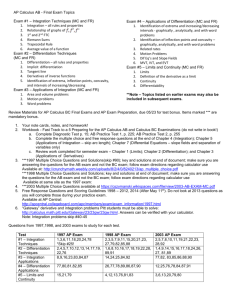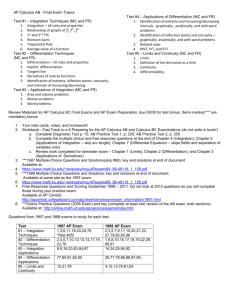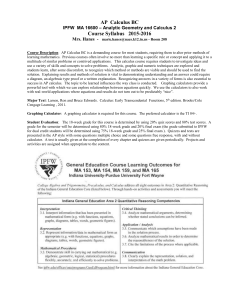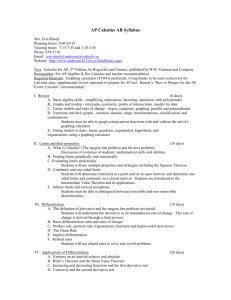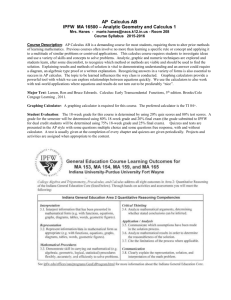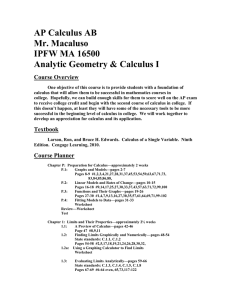AP Calculus AB
advertisement
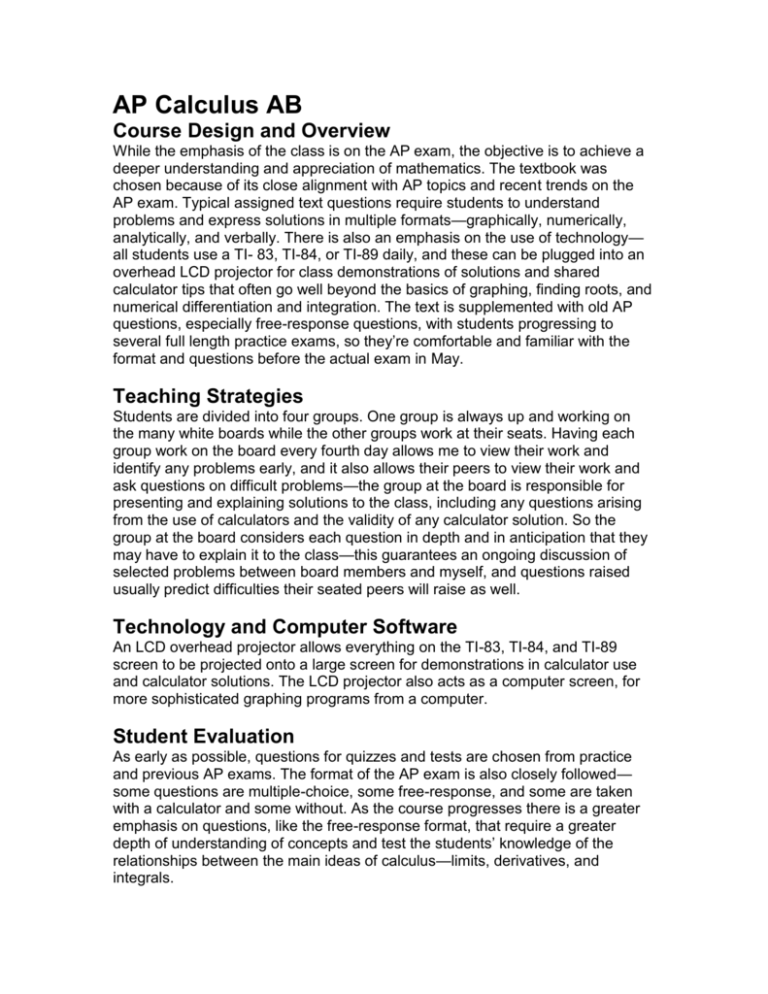
AP Calculus AB Course Design and Overview While the emphasis of the class is on the AP exam, the objective is to achieve a deeper understanding and appreciation of mathematics. The textbook was chosen because of its close alignment with AP topics and recent trends on the AP exam. Typical assigned text questions require students to understand problems and express solutions in multiple formats—graphically, numerically, analytically, and verbally. There is also an emphasis on the use of technology— all students use a TI- 83, TI-84, or TI-89 daily, and these can be plugged into an overhead LCD projector for class demonstrations of solutions and shared calculator tips that often go well beyond the basics of graphing, finding roots, and numerical differentiation and integration. The text is supplemented with old AP questions, especially free-response questions, with students progressing to several full length practice exams, so they’re comfortable and familiar with the format and questions before the actual exam in May. Teaching Strategies Students are divided into four groups. One group is always up and working on the many white boards while the other groups work at their seats. Having each group work on the board every fourth day allows me to view their work and identify any problems early, and it also allows their peers to view their work and ask questions on difficult problems—the group at the board is responsible for presenting and explaining solutions to the class, including any questions arising from the use of calculators and the validity of any calculator solution. So the group at the board considers each question in depth and in anticipation that they may have to explain it to the class—this guarantees an ongoing discussion of selected problems between board members and myself, and questions raised usually predict difficulties their seated peers will raise as well. Technology and Computer Software An LCD overhead projector allows everything on the TI-83, TI-84, and TI-89 screen to be projected onto a large screen for demonstrations in calculator use and calculator solutions. The LCD projector also acts as a computer screen, for more sophisticated graphing programs from a computer. Student Evaluation As early as possible, questions for quizzes and tests are chosen from practice and previous AP exams. The format of the AP exam is also closely followed— some questions are multiple-choice, some free-response, and some are taken with a calculator and some without. As the course progresses there is a greater emphasis on questions, like the free-response format, that require a greater depth of understanding of concepts and test the students’ knowledge of the relationships between the main ideas of calculus—limits, derivatives, and integrals. Student Activities All students are required to give presentations, often as part of a group, but individual presentations are also required. A wide variety of problems are chosen so that students experience the three different ways of viewing a function, graphically, numerically, and analytically, and the presentations also require a student to demonstrate one of the four basic skills required on a graphing calculator. Limits offer a quick example—calculators, with their graphing and table features often give students some insight to finding limits that are more difficult to find analytically, but there is also the danger of false results because they often can’t show enough detail—an infinite number of oscillations, for example. Limits give students their first obvious view of functions as tables, graphs, and equations, and some early experience with a calculator in finding solutions. Class Textbook Larson, Ron, Robert P. Hostetler, and Bruce H. Edwards. Calculus of a Single Variable. 8th ed. Boston: Houghton Mifflin, 2006. Calculus AB Chapter Sequence Times given in parenthesis are approximate and flexible and intended for the initial exposure. Time is allowed for the class to periodically stop and review previous material, and to spend extra time on more difficult material. Also several weeks are budgeted for a complete review in the weeks preceeding the exam. Preparation for Calculus (3-4 days) P.1 Graphs and Models P.2 Linear Models and Rates of Change P.3 Functions and Their Graphs P.4 Fitting Models to data Limits and Their Properties (3 weeks) 1.1 A Preview of Calculus 1.2 Finding Limits Graphically and Numerically 1.3 Evaluating Limits Analytically 1.4 Continuity and One-Sided Limits 1.5 Infinite Limits Differentiation (3 weeks) 2.1 The Derivative and the Tangent Line Problem 2.2 Basic Differentiation Rules and Rates of Change 2.3 Product and Quotient Rules and Higher-Order Derivatives 2.4 The Chain Rule 2.5 Implicit Differentiation 2.6 Related Rates Applications of Differentiation (4 weeks) 3.1 Extrema on an Interval 3.2 Rolle’s Theorem and the Mean Value Theorem 3.3 Increasing and Decreasing Functions and the First Derivative Test 3.4 Concavity and the Second Derivative Test 3.5 Limits at Infinity 3.6 A Summary of Curve Sketching 3.7 Optimization Problems 3.8 Newton’s Method 3.9 Differentials Integration (3 weeks) 4.1 Antiderivatives and Indefinite Integration 4.2 Area 4.3 Riemann Sums and Definite Integrals 4.4 The Fundamental Theorem of Calculus 4.5 Integration by Substitution 4.6 Numerical Integration Logarithmic, Exponential, and Other Transcendental Functions (2 weeks) 5.1 The Natural Logarithmic Function: Differentiation 5.2 The Natural Logarithmic Function: Integration 5.3 Inverse Functions 5.4 Exponential Functions: Differentiation and Integration 5.5 Bases Other Than e and Applications 5.6 Inverse Trigonometric Functions: Differentiation 5.7 Inverse Trigonometric Functions: Integration Differential Equations (2 weeks) 6.1 Slope Fields and Euler’s Method 6.2 Differential Equations: Growth and Decay 6.3 Seperation of Variables and the Logistic Equation 6.4 First-Order Linear Differential Equations Applications of Integration (3 weeks) 7.1 Area of a Region Between Two Curves 7.2 Volume: The Disk Method 7.3 Volume: The Shell Method After the AP Exam (Possible Topics chosen in previous years) A.E. Cryptography and Modular Arithmetic A.E. Linear Algebra A.E. Integration by Parts A.E. Trigonometric Substitution A.E. Partial Fractions A.E. Indeterminate Forms and L’Hopital’s Rule A.E. Improper Integrals
